Early conversations with MEL Consultants at the conceptual stage of the design process can help to avoid wind-related problems for the completed project. Past experience with hundreds of wind-tunnel studies can flag considerations regarding building shape, orientation, entry location, balcony/terrace siting, likely dynamic response, and general massing; without recourse to the wind tunnel in the initial phases of the design. As the design evolves, and its various features become firmer, the MEL team can advise on what wind-tunnel investigations (if any) might benefit the end product. If the code approach to the structural and cladding design is a reasonable methodology (say, a rectilinear building with a standard structural system in well defined surroundings) we will advise how to most efficiently use the relevant wind load standard.
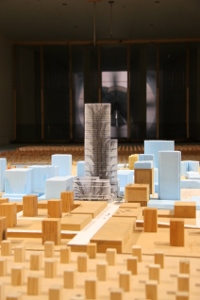 Typically, no. The architectural model is usually not strong enough for use in a boundary-layer wind tunnel where velocities are typically in the range of 15 to 30 m/s. Also, the model will commonly need to have hundreds of pressure taps installed over its surface so that cladding pressure data may be obtained. Consequently, MEL will build its own engineering model of your project (with the surrounding few blocks of proximate structures built of wood or architectural foam) to be instrumented for the desired data collection. In the case of the pressure model, it is made of Plexiglas or a hardened polymer from the stereolithography process, and in the case of a structural model a lightweight material is generally used like balsawood or carbon fibre.
Typically, no. The architectural model is usually not strong enough for use in a boundary-layer wind tunnel where velocities are typically in the range of 15 to 30 m/s. Also, the model will commonly need to have hundreds of pressure taps installed over its surface so that cladding pressure data may be obtained. Consequently, MEL will build its own engineering model of your project (with the surrounding few blocks of proximate structures built of wood or architectural foam) to be instrumented for the desired data collection. In the case of the pressure model, it is made of Plexiglas or a hardened polymer from the stereolithography process, and in the case of a structural model a lightweight material is generally used like balsawood or carbon fibre.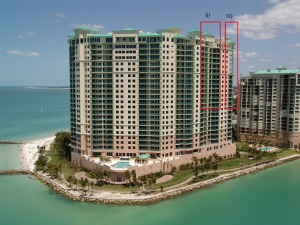 There are many factors that influence the wind conditions on the balconies and elevated terraces of tall residential buildings. These may include: building shape, elevation relative to proximate buildings, elevation above ground, orientation combined with the local wind statistics, impact of neighbours (both shielding and accelerated flows), exposure to oncoming wind, and balcony location. Some of these variables are under the control of the design team, but many are not.
There are many factors that influence the wind conditions on the balconies and elevated terraces of tall residential buildings. These may include: building shape, elevation relative to proximate buildings, elevation above ground, orientation combined with the local wind statistics, impact of neighbours (both shielding and accelerated flows), exposure to oncoming wind, and balcony location. Some of these variables are under the control of the design team, but many are not.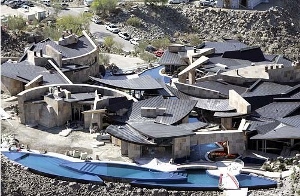 In the early days of wind-tunnel testing of buildings (say, the 1960s and 1970s) the process was relatively more expensive than today and it was considered more exotic. Thus, it tended to be used in the design of tall buildings only. This resulted in a perception that buildings less than, say, thirty storeys would not benefit from such physical modelling in the wind tunnel. In recent decades the real cost has come down substantially, and the level of architectural complexity has increased markedly.
In the early days of wind-tunnel testing of buildings (say, the 1960s and 1970s) the process was relatively more expensive than today and it was considered more exotic. Thus, it tended to be used in the design of tall buildings only. This resulted in a perception that buildings less than, say, thirty storeys would not benefit from such physical modelling in the wind tunnel. In recent decades the real cost has come down substantially, and the level of architectural complexity has increased markedly.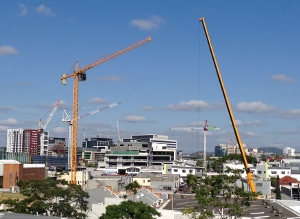 At first glance it may seem obvious that how the wind applies pressure to the external skin of a building would demand that the internal structure of the building would need to resist the same loads. However, the reality is actually quite different.
At first glance it may seem obvious that how the wind applies pressure to the external skin of a building would demand that the internal structure of the building would need to resist the same loads. However, the reality is actually quite different.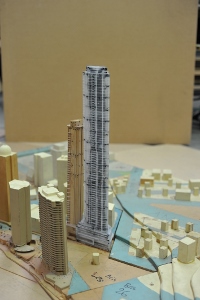 The most common way that the designer establishes the expected pressures on the external envelope of your new building is to use the latest Australian Standard (AS/NZS1170.2). This document was generated by a knowledgeable committee using hundreds of wind-tunnel studies and, since it has to apply to many geometries and locales, it is a somewhat conservative document. By performing a site-specific, building-specific wind-tunnel study the design team obtains the actual wind pressure distribution over their new building; effectively placing the "money" where it is needed. The wind-tunnel model will include the nearby buildings and any terrain of consequence; neither of which are adequately addressed in the AS/NZS1170 analysis.
The most common way that the designer establishes the expected pressures on the external envelope of your new building is to use the latest Australian Standard (AS/NZS1170.2). This document was generated by a knowledgeable committee using hundreds of wind-tunnel studies and, since it has to apply to many geometries and locales, it is a somewhat conservative document. By performing a site-specific, building-specific wind-tunnel study the design team obtains the actual wind pressure distribution over their new building; effectively placing the "money" where it is needed. The wind-tunnel model will include the nearby buildings and any terrain of consequence; neither of which are adequately addressed in the AS/NZS1170 analysis.
Additionally as architects design more interesting building shapes the Australian Standard becomes more difficult to apply, since the pressure guidance in that document targets more conventional geometries such as rectilinear buildings. A wind-tunnel study of your project will generate a better understanding of the design wind pressures on the walls, roof and major appurtenances yielding more confidence in the integrity of the design and, frequently, generating savings at the same time.
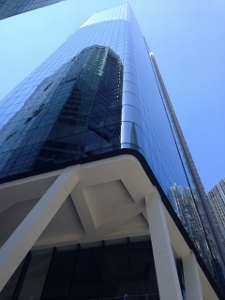 The most common way that the designer of a new building establishes the expected wind pressures and structural wind loads is to use the latest Australian Standard (AS/NZS1170.2), or similar document pertinent to the geographic region of the site. These documents are generated by knowledgeable committees using hundreds of wind-tunnel studies and, since these methodologies have to apply to many geometries and locales, they are somewhat conservative documents. By performing a site-specific, building-specific, wind-tunnel study the design team obtains the actual peak structural wind loads or the true wind pressure distribution over their new building; effectively placing the "money" where it is needed. Additionally, on the rare occasions that the shape of the subject building, or the influence of nearby buildings, generates wind pressures and/or wind loads larger than the code calculations the design team needs to know that is the case, so that the design is adequate. A pure code approach would miss these rare eventualities. The wind-tunnel model will include the impact of nearby buildings and any terrain of consequence; neither of which are adequately addressed in the AS/NZS1170 analysis or other code/standard.
The most common way that the designer of a new building establishes the expected wind pressures and structural wind loads is to use the latest Australian Standard (AS/NZS1170.2), or similar document pertinent to the geographic region of the site. These documents are generated by knowledgeable committees using hundreds of wind-tunnel studies and, since these methodologies have to apply to many geometries and locales, they are somewhat conservative documents. By performing a site-specific, building-specific, wind-tunnel study the design team obtains the actual peak structural wind loads or the true wind pressure distribution over their new building; effectively placing the "money" where it is needed. Additionally, on the rare occasions that the shape of the subject building, or the influence of nearby buildings, generates wind pressures and/or wind loads larger than the code calculations the design team needs to know that is the case, so that the design is adequate. A pure code approach would miss these rare eventualities. The wind-tunnel model will include the impact of nearby buildings and any terrain of consequence; neither of which are adequately addressed in the AS/NZS1170 analysis or other code/standard.
Thus, a wind-tunnel study yields a truer understanding of the design wind loads, often resulting in reduced cladding and structural expenses. On the rare occasions that the discovery of larger than expected loads and pressures occurs the design team needs to know these data to ensure a responsible design. In the case of tall slender building designs the wind tunnel will yield information about the motion to be expected on the upper floors that may actually control the design.
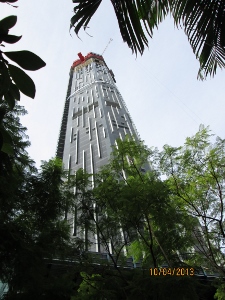 The structure of a tall building ensures that it deflects under any loading and wind is no exception. The wind will travel around a tall building in such a way that it experiences loading that is both static and dynamic. The latter loading can be sympathetic to the eddies in the wind near the building, that are a similar size to the building itself, and so move it in such a way that the occupants may be able sense the motion. As humans we sense the accelerations rather than displacement or velocity. For example, in a lift or elevator one notices the initial acceleration and final deceleration, but not the intervening velocity or displacement. The same is so for the horizontal motion in a tall building. The displacements may be quite large in a very tall building, but it is the accelerations that one feels. Your wind engineer will work with the structural engineer to obtain the needed amount of mass, stiffness, and damping to make the upper-level building motions imperceptible.
The structure of a tall building ensures that it deflects under any loading and wind is no exception. The wind will travel around a tall building in such a way that it experiences loading that is both static and dynamic. The latter loading can be sympathetic to the eddies in the wind near the building, that are a similar size to the building itself, and so move it in such a way that the occupants may be able sense the motion. As humans we sense the accelerations rather than displacement or velocity. For example, in a lift or elevator one notices the initial acceleration and final deceleration, but not the intervening velocity or displacement. The same is so for the horizontal motion in a tall building. The displacements may be quite large in a very tall building, but it is the accelerations that one feels. Your wind engineer will work with the structural engineer to obtain the needed amount of mass, stiffness, and damping to make the upper-level building motions imperceptible.